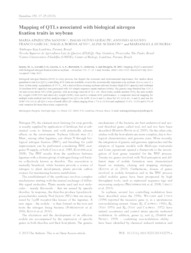Mapping of QTLs associated with biological nitrogen fixation traits in soybean.
Mapping of QTLs associated with biological nitrogen fixation traits in soybean.
Autoria: SANTOS, M. A.; GERALDI, I. O.; GARCIA, A. A. F.; BORTOLATTO, N.; SCHIAVON, A.; HUNGRIA, M.
Resumo: Biological nitrogen fi xation (BNF) is a key process, but despite the economic and environmental importance, few studies about quantitative trait loci (QTL) controlling BNF traits are available, even in the economically important crop soybean Glycine max (L.) Merr. In this study, a population of 157 F 2:7 RILs derived from crossing soybean cultivars Bossier (high BNF capacity) and Embrapa 20 (medium BNF capacity) was genotyped with 105 simple sequence repeat markers (SSRs). The genetic map obtained has 1231.2 cM and covers about 50% of the genome, with an average interval of 18.1 cM. Three traits, nodule number (NN), the ratio nodule dry weight (NDW)/NN and shoot dry weight (SDW) were used to evaluate BNF performance. A composite interval mapping for multiple traits method (mCIM) analysis mapped two QTLs for SDW (LGs E and L), three for NN (LGs B1, E and I), and one for NDW/NN (LG I); all QTLs were of small effect (R 2 -values ranging from 1.7% to 10.0%) and explained 15.4%, 13.8% and 6.5% of total variation for these three traits, respectively.
Ano de publicação: 2013
Tipo de publicação: Artigo de periódico
Unidade: Embrapa Soja
Palavras-chave: Fixação de nitrogênio, Nitrogen fixation, Soja, Soybeans
Observações
1 - Por padrão são exibidas publicações dos últimos 20 anos. Para encontrar publicações mais antigas, configure o filtro ano de publicação, colocando o ano a partir do qual você deseja encontrar publicações. O filtro está na coluna da esquerda na busca acima.
2 - Para ler algumas publicações da Embrapa (apenas as que estão em formato ePub), é necessário ter, no celular ou computador, um desses softwares gratuitos. Sistemas Android: Google Play Livros; IOS: iBooks; Windows e Linux: software Calibre.
Acesse outras publicações
Acesse a Base de Dados da Pesquisa Agropecuária (BDPA) para consultar o acervo completo das bibliotecas da Embrapa.

